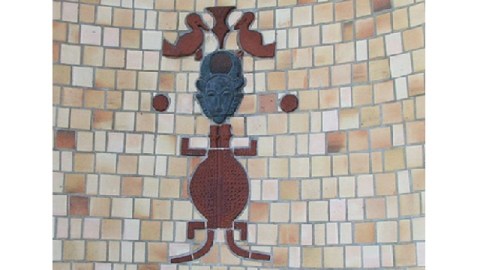Dark Continent: Africa as Seen in American Art Museums

Two years before opening his Barnes Foundation in 1925, Dr. Albert C. Barnes vowed that in his new institution, “negro art will have a place among the great art manifestations of all times.” Such lofty goals and noble aspirations mark much of the history of American art museums in their quest to collect, display, and represent African culture through its art. Representing Africa in American Art Museums: A Century of Collecting and Display, edited by Kathleen Bickford Berzock and Christa Clarke, traces that long history by collecting the institutional stories of 13 museums that have played key roles in how African art is seen in the United States. Situated outside of the Western tradition, African art poses a challenge to the conventional thinking of the standard museum model. Sincere attempts to illuminate the realm once known as the “Dark Continent” sometimes led to even more obscurity and confusion, but the story of American art museums coming to terms with the fruits of Africa is ultimately a success story, still in the making.
The Cincinnati Museum of Art lays claim to being the first U.S. art museum to purchase and display a collection of African art in 1899 after buying the collection of Carl Steckelmann, who had worked as a trading agent in Africa for a decade. Natural history museums and private collectors began to collect African art more intensely throughout the late 1800s thanks to improved travel to and more opportunities for trade and study in Africa, but, as Berzock and Clarke explain in their introduction, “it was the art museum that more profoundly shaped the representation of African art and pioneered its establishment and acceptance in both scholarly and public arenas.” Unfortunately, the sheer diversity of forms and materials used in African art, as well as the immense number of cultures largely unfamiliar to the West, “were not suited to the aesthetic hierarchies and systems of classification established by art museums,” Berzock and Clarke write.
At the heart of this classification conundrum rested the question of what is “art” and what is an “artifact.” Textiles and other functional items found themselves shuttled off to natural history museums, much like decorative quilts and other items associated with women suffered segregation from the art world. “Art” came to be identified with purely aesthetic qualities in the twentieth century museum in a formalistic approach that ignored the larger cultural context.
Clarke, who wrote her doctoral dissertation on African art at the Barnes Foundation, explains the central role of Dr. Barnes in developing a new vision of African art in America that would stand as an inspiration to the African-American community.
As Clarke demonstrates, Barnes’ fascination with “plastic form” in art led him “to regard African sculpture as the purest expression of three-dimensional form.” Barnes created the Barnes Foundation as an educational institution for all people, but had a specific interest in improving the lives of those who worked in his chemical factory, most of whom were black. After using his African art collection to educate his workers, Clarke writes,“Barnes [came] to see potential in African sculpture as an important tool for educational and social reform in the African American community.” At a time when African Americans still struggled for equality and a sense of pride, Barnes’ educational scheme offered them a way to look back at their African roots to look forward to greater things. The African-American artist Aaron Douglas attended the Barnes Foundation as a student and incorporated that cultural pride in his works, which is just one example of the power of Barnes’ plan.
Barnes came to see African Americans as “natural aesthetes,” Clarke continues, “whose integration of art and life resulted from their collective memory of traditional African culture.” As well-intentioned as Barnes was, his view of African art and African Americans leaned heavily on a “racial essentialism” and a kind of “paternalism,” to use Clarke’s words, that ignored the individuality of African Americans. Additionally, Barnes’ view of African art was much more selective than inclusive. A lover of the French art from Renoir to Matisse, Barnes collected almost exclusively from regions of Africa that had been French colonies and, even worse, characterized the art of other regions as second rate. Barnes also fell into the art versus artifact trap and loaded his collection with masks and figural sculptures that neatly fell into his eccentric gallery presentations beside works by modern European artists such as Modigliani and Picasso, who admitted their debt to African “primitivism.” Barnes went so far as to incorporate African motifs into the classically influenced exterior of the Barnes Foundation, including the main entrance (detail shown above). The marriage of Western and African styles, Clarke asserts, embodies Barnes’ belief that “African sculpture—the greatest example of three-dimensional form—liberated the Western tradition of representative art from the constraint of classicism.” In other words, the modern art movements that turned the Western tradition on its head would have never happened without the rise of African art in the late nineteenth century (however misrepresentative it may have been).
Barnes really stands out as the hero (albeit slightly tarnished) of African art in America, influencing in some way every other landmark afterwards—from the momentous 1935 show of African art at the MoMA that really opened the eyes of the public and other museums all the way up to the establishment of a National Museum of African Art. Especially during Black History Month, but also throughout the year, it’s important to focus on how our cultural institutions have shaped our thinking about other cultures. Representing Africa in American Art Museums: A Century of Collecting and Display reminds us that African culture is much more diverse than we think. Names such as Gabon, Dogon, Benin, Mende, Fang, and others often disappear beneath the blanket of “African art.” Museums today try to uncover and recover the diversity lost in earlier displays.
If the road traveled by African art in American museums is paved with good intentions, Berzock and Clarke in their selection of essays seek to examine those good intentions tainted by hierarchies and agendas that served the museums more than African art and, most importantly, those looking to that art for understanding, either of another culture or their own heritage. Best of all, Representing Africa in American Art Museums reminds us that Africa was a “Dark Continent” not because it lacked the guiding light of culture and art, but because our own ignorance and misunderstanding overshadowed it.
[Many thanks to the University of Washington Press for providing me with a review copy of Representing Africa in American Art Museums: A Century of Collecting and Display, edited by Kathleen Bickford Berzock and Christa Clarke.]





